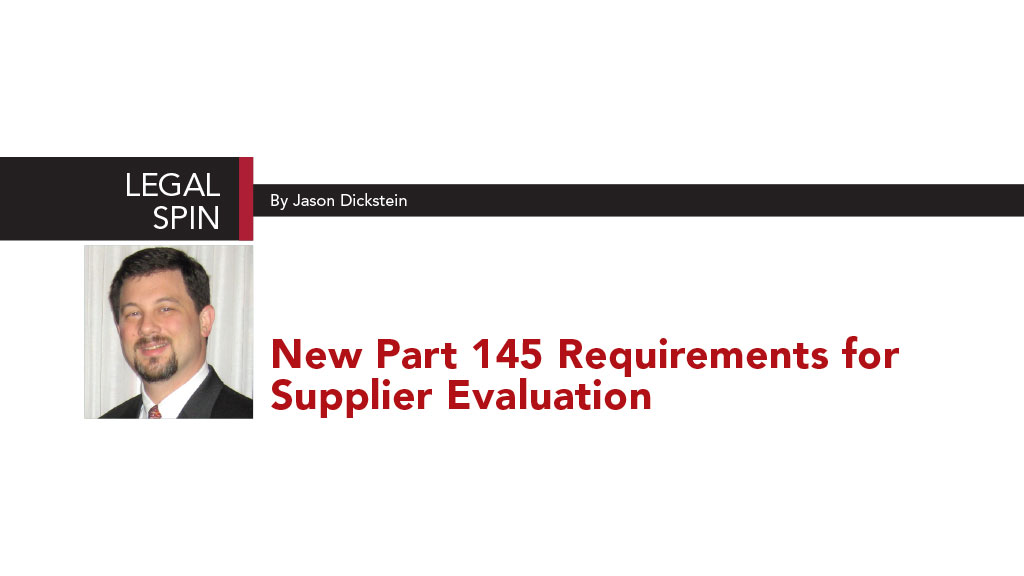Is your Part 145 organization evaluating its suppliers? A new European rule now requires Part 145 organizations to engage in supplier evaluation.
The new standards offer a number of different strategies for accomplishing this evaluation, so it doesn’t have to be a burden; but it has become a requirement, so Part 145 organizations ought to ensure they are meeting the applicable requirements in all cases.
Many repair stations appear to have missed this change, because it has been introduced without much fanfare. It starts with a minor change in the regulations that was published last summer. In August, the European Commission issued a new rule that required repair stations (EASA 145 organization) to
“establish procedures for the acceptance of components, standard parts and materials for installation to ensure that components, standard parts and materials are in satisfactory condition and meet the applicable requirements” EASA 145.A.42(b)(i).
At first blush, this does not seem to foreshadow any change at all. Everyone has procedures for accepting components. But when you get into the official guidance material, the meaning of these words becomes more plain.
The official guidance material was issued in a March 28 EASA Executive Decision (ED Decision 2019/009/R), and it was made more widely available when it was published in the EASA Easy Access Regulations in April.
First, the guidance clarifies that
“[f]or the acceptance of components, standard parts and materials from suppliers, the [] procedures should include supplier evaluation procedures.” AMC1 145.A.42(b)(i), section (b).
If you look at this requirement without continuing to read the rest of the guidance, then this takes a small burden (acceptance procedures) and turns it in to a seemingly huge burden (supplier auditing). But the EASA regulators are clever, and they provided mechanisms to protect aviation safety by using existing best-industry-practices.
How Did We Get Here?
The reason for supplier evaluation is because the supply chain can be a source of safety jeopardy. This was recognized globally in the 1980s and 1990s. In the 1990s, the United States FAA created the Voluntary Industry Distributor Accreditation Program (“Accreditation Program”). This voluntary accreditation program encouraged aircraft parts suppliers to adopt quality system standards that protected the airworthiness of parts, and that helped to support traceability. The program endorsed quality assurance standards and identified qualified audit organizations that could audit and confirm compliance to the voluntary standards. Suppliers that chose to implement the voluntary standards, and who received an independent audit confirming compliance, could be listed on an FAA database of accredited suppliers.
At about the same time, Europe’s Joint Aviation Authorities (JAA) recognized the value in inventory control and issued Temporary Guidance Letters (TGLs) addressing subjects like inspecting parts and controlling suppliers through effective evaluation. EASA effectively supplanted the JAA, but it took on some of the JAA initiatives including supplier control.
About ten years ago, EASA formed a rulemaking committee to investigate options for supplier control. The EASA committee independently created its own list of preferred quality system elements, and then compared them to the list found in the FAA’s Accreditation Program. The lists matched.
After significant research and discussion, the EASA committee concluded that the existing FAA Accreditation Program had become global in scope (and was used extensively in Europe), and they concluded that the Program adequately served the industry’s safety needs for supplier control (through supplier evaluation).
The long path from EASA recommendation to European Commission regulation resulted in the new regulation highlighted at the beginning of this column (EASA 145.A.42(b)(i)).
How Do I Comply?
As I said, the EASA Acceptable Means of Compliance (AMC) guidance appears to impose a huge new obligation on repair stations to evaluate suppliers. But EASA has offered an easy way to meet this evaluation obligation, by relying on the existing infrastructure for supplier evaluation.
EASA guidance material (GM3 145.A.42(b)(i)) explains how to evaluate suppliers. It explains that the 145 organization should ensure that the supplier’s quality system successfully incorporates certain specific elements. It explains that suppliers who meet those elements are considered acceptable, and that there are four standards that incorporate all of the necessary elements. The four standards are AC 00-56, ASA-100, AS/EN9120 and EASO 2012, and a supplier that is known to meet those elements is considered acceptable.
This means that a 145 organization can rely on the third party evaluation of a supplier that was audited to such a standard, and the 145 organization does not have to expend resources on its own, independent, supplier evaluation.
The easiest of these standards to use is AC 00-56, because you can find the FAA’s list of accredited suppliers online at https://www.aviationsuppliers.org/FAA-AC-00-56B. This is the list that most commercial aviation installers use when looking for aircraft parts suppliers, and it is easy to use for searching and for identifying important information (like certificate expiration dates).
What do you do about suppliers who are not accredited to a recognized standard? You can encourage them to get accredited (this makes it easy for you) or you can evaluate them yourselves. The EASA guidance material clarifies that a 145 organization’s level of supplier surveillance will vary based on the hazards and risks posed by the supplier. A supplier with little to no effect on safety could be given a simple paper checklist, but a supplier who provides safety-sensitive parts may need to be subject to periodic live audits. The burden associated with maintaining an external auditing force is one reason why most 145 organizations will opt to rely on third party accreditation.
Disclosure: Jason Dickstein is the General Counsel of the Aviation Suppliers Association, and was a member of the EASA rulemaking committee described in this article.
